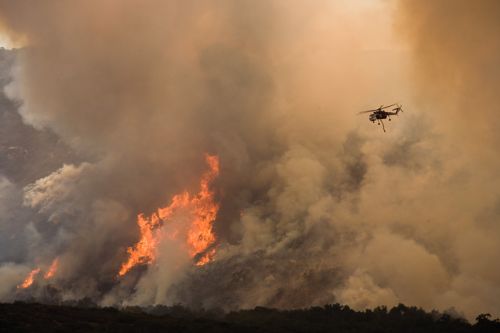by Larry
September, 2017Forever FiresThe U.S. fire season used to be mainly during our summer months. As droughts have occurred, temperatures have risen, diseases or insect predation have decimated trees in large areas, natural burning - for instance due to lightning strikes - has been suppressed, the amount of unburned dead material in our forests has increased, and human development has expanded into previously wilderness regions, the challenges have grown in scope, duration, cost, and firefighting hazard. Certain areas, for example in southern CA, even have fires that must now be battled year-round. All this is having effects beyond the immediate scenes of our current conflagrations. The amount of forest material being burned is on average twice that in the mid-1980s. Smoke is affecting those with asthma and other respiratory conditions not merely nearby but hundreds of miles from the latest fires. Fires, especially but not exclusively in the west, are becoming a perpetual phenomenon both in the Lower 48 and in AK. As firefighting is now often needed in all seasons, our new normal is referred to as the Pyrocene or fires epoch. Just as the Pleistocene was a time when ice covered much of Earth, so these days fires threaten to overwhelm much of the planet. Combustion from fossil fuels and from forests are warming the surface of the globe, so another candidate for our age's name is Thermocene. Whatever we call this time, insurance rates are going up, government-related costs are skyrocketing, and combating large, out-of-control fires is vying with hurricanes, floods, and other natural events for the most devastating of modern emergencies. In 2015, over 10 million acres (about 15,625 square miles) burned in the U.S. That's an area greater than MA, DE, RI, and the District of Columbia combined. Thus far, the national firefighting scene has been easier in 2017, but is still intense in CA, ID, MT, OR, and WA. Recent wetter winters appeared to offer relief but instead encouraged the growth of sagebrush, rabbitgrass, and cheatgrass, excellent fire fuel. Along with the devastation to forests in such vast areas, there are of course attendant destructions at least temporarily to the ecology, watersheds, and wildlife. The west's Great Basin evidently has the worst of it, yet other regions are not immune. This year has seen nearly 2 million acres of fires in forests or grasslands of FL, NC, OK, SC, and TX. The U.S. Forest Service might by rights be called the Fire Service. In 2015, for instance, over half its budget went to fighting fires. The added frequency and intensity of the fires has also called for beefed up efforts to deal with them and often involves teams of firefighters with their equipment and vehicles going in up to 12 months of each year. More firefighter injuries and deaths are occurring. In a typical year, thousands of buildings are also being destroyed by the blazes.
With a single, simple source of ignition, be it a thrown out cigarette, a catalytic converter, a campfire not adequately put out, a lightning strike, or the efforts of an arsonist, the right (wrong) combinations of fuel, weather, and topography assure annually many great, fast moving, highly dangerous fires. Such combustion, frequently driven by wind, respects no fences, few roads, and not many structures. Large fires affect nearby weather, especially wind. They can even jump over streams and can race toward us faster than children, pets, or even adults can run. Just as recent Hurricanes Harvey and Irma forced many to evacuate their homes or seek shelter with minutes or seconds to spare, fires can seem to come from all directions at once and can give potential victims only moments to make life or death choices. Major additional aspects of fire and especially smoke proximity are their adverse effects on our breathing and vision. People die from confusion in a fire setting, not knowing which way to flee, or from smoke inhalation and asphyxiation rather than necessarily from being fatally burned. As with greater numbers and intensities of severe weather events like tornadoes and hurricanes, more problems can be expected from forest and grassland fires. It appears that for the foreseeable future they will be with us. Metropolitan areas are not free of these hazards. Suburban residential developments can be quickly engulfed in flames. From personal experience, I have a healthy respect for combustion. As a child I had a couple near tragedies involving fire. Once I thought it would be interesting inside our house to see how quickly a trashcan full of paper flamed up after being lit with one of my matches, then was dismayed to see in seconds it become a roaring torch. I burned by hands and face as I rushed it out to the nearest outside faucet. Another time, I started a little campfire in a big field out behind our house, a former orchard. A few minutes later the wind had caught and spread the flames and almost the whole field plus some of its wooden fencing were engulfed in flames. The volunteer fire department put everything out in time, or it would have burned nearby houses as well. A brother was playing with homemade rockets, from one of which a fire quickly spread over several acres before finally brought under control after several relatives rushed to his aid. Just as more insects, molds, allergens, diseases, and parasites can move north (and south) into formerly temperate climate zones, the danger and reality of more conflagrations are inevitable as temperatures increase. The importance of dedicated teams of professional and volunteer fighters of these fires has never been greater.
Primary sources: |
